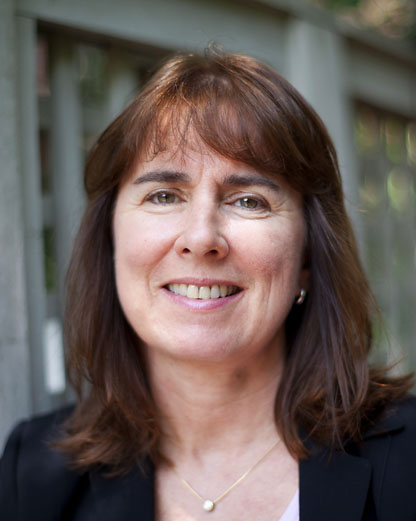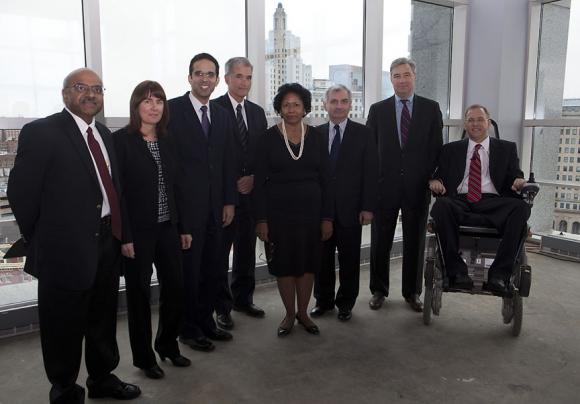PROVIDENCE, R.I. [Brown University] — Brown University leaders, federal and local elected officials, the National Science Foundation and corporate supporters gathered Monday, March 7, 2011, to celebrate a $15.5-million national mathematics research institute, which promises to expand the frontier of computation and mathematics, create jobs and bring thousands of visitors to Rhode Island.
The NSF awarded the Institute for Computational and Experimental Research in Mathematics (ICERM) to Brown in August. It is the eighth math institute in the United States funded by the NSF and the only one of its kind in New England. It officially opens this fall at 121 South Main Street, in the emerging Knowledge District of Providence. ICERM's funding covers its first five years of operation, at which point it will seek to extend funding for another five years, as is customary with other NSF-funded math institutes.
ICERM is the only institute charged with studying the convergence of mathematics and computation. The field is new, and it holds great promise to spin off technologies that could transform society. Contemporary subjects that internationally recognized scholars are expected to tackle in semester-long programs, scholarly conferences, “hot topics” workshops and other initiatives include climate change, cryptography, cyber security, energy production and distribution, finance, personalized medicine, search engines, and social networks.
“The Institute brings leaders in applied mathematics, mathematics and related fields to join with Brown scholars to explore new ideas and advance our understanding of broader applications of math,” said Brown President Ruth J. Simmons. “That Brown competed successfully for this important award is a testament to the quality of our faculty and our commitment to research excellence.”
“At a time when job creation and innovation are our highest priorities, the Institute for Computational and Experimental Research in Mathematics in Providence will help bring both to the state. This project will not only advance mathematical sciences research and education in New England, but it will also create jobs, attract leading mathematicians to Rhode Island, and make Providence an important hub for the study of computational mathematics,” said Sen. Jack Reed (D-RI), a member of the Appropriations Subcommittee that provides all federal funding for the National Science Foundation. In February 2009, Reed wrote a letter supporting Brown’s application for the federal funding.
Each NSF-funded mathematical research institute has a specific mission. “What makes ICERM unique is its exploration of the intersection of mathematics and computation,” said Jill Pipher, professor of mathematics and ICERM’s director. “Experimentation has always been a part of mathematics, but today’s computational tools, power, and resources make possible visualization and experimentation on a whole new scale.”

Ideas and jobs
NSF math institutes are renowned for spinning off ideas that become companies, companies that create products, and products that better society. ICERM has partnered with three of the world’s pre-eminent computer hardware and software companies — Google, IBM, and Microsoft. Through these relationships, ideas can flow, resulting in ventures that capitalize on the wealth of intellectual talent at ICERM.
“In his State of the Union address, President Obama talked about the need for America to out-educate and out-innovate the rest of the world. This new institute can help put our state at the forefront of that effort while creating jobs here in Rhode Island,” said Sen. Sheldon Whitehouse.
ICERM will bring jobs and visitors to Providence and to the state. It will employ nine full-time staff, support up to 40 researchers in residence, and fund up to a dozen postdoctoral researchers in the first year. Around 1,000 visitors to ICERM are expected annually; they are projected to book 2,200 hotel rooms and spend more than $500,000 yearly on lodging and meals alone in greater Providence, according to the institute.
"The City of Providence is tremendously proud to celebrate the establishment of the Institute for Computational and Experimental Research in Mathematics at Brown University," said Providence Mayor Angel Taveras. "The Institute will be an important locus of economic activity for our city and represents a significant investment in the future of Providence's knowledge economy."

Continuing education
ICERM will seek to train the next generation of mathematical and computational scientists. Many recent studies, including a 2008 report from the National Academy of Sciences, note that a concerted effort is needed to bolster the nation’s competitiveness and pre-eminence in science and technology. To that end, the institute will form an education board that will be charged with overseeing the undergraduate programs and graduate training and seeking federal and foundation support to host education summits and other activities aimed at improving instruction in the mathematical sciences at the K-12 level.
“I am delighted to welcome the newest member of our knowledge economy to Providence," said Rep. James Langevin (D-RI). “As the co-chair of the Congressional Cybersecurity Caucus, I know how important the mathematics research done here will be to our economy and to our national security. The scientific advances that come out of ICERM also will drive private sector innovation, creating high quality jobs for Rhode Islanders. I commend the National Science Foundation and Brown University for this investment, and I will continue to work to ensure full funding for math and science at the federal level.”
The institute is the next step in the long history of mathematics and applied mathematics at Brown. The Department of Mathematics awarded its first Ph.D. in 1929 and has produced scores of graduates who populate top-level mathematics departments and hold prominent positions in industry. Established in 1941, the Division of Applied Mathematics is among the strongest programs of its kind in the country. The division’s research strengths are in applied probability and statistics, computational molecular biology, differential equations and dynamical systems, fluid mechanics, scientific computation, stochastic control and optimization and vision research.
“Brown would never have been awarded this institute without the distinguished reputation and solid science in mathematics and applied mathematics that has existed for decades,” Pipher said.
Other voices
Other leaders who are interested in the work of ICERM but were unable to attend the Monday event sent greetings and congratulations.
Gov. Lincoln Chafee:
“This award represents an investment in the future of Rhode Island. The Institute for Computational and Experimental Research in Mathematics will be a significant driver for job creation and economic growth in our capital city and our state as a whole. As we work to make Rhode Island a leader in the new economy, we will depend more and more on research, new discoveries, new technologies and long-term investments in emerging industries to create the jobs of the future.”
U.S. Rep. David Cicilline
“This federal award, which has led to the launch of this institute, is a great example of how federal investment in research, innovation, and science leads directly to job creation. If we are going to compete successfully in the global economy of the 21st century, we cannot lose our competitive edge and we must invest in our education system, especially in the fields of math and computer sciences.”
Jennifer Tour Chayes, managing director, Microsoft Research New England:
“Many of the most fascinating problems in technology lie at the interface of mathematics, computation and data analysis. ICERM will be at the center of next-generation thinking around these important challenges. Together we hope to shape tomorrow’s technology.”
Background on ICERM
Mission
ICERM’s mission is to support and broaden the relationship between mathematics and computation — specifically, to expand the use of computational and experimental methods in mathematics, to support theoretical advances related to computation, and to address problems posed by the existence and use of the computer through mathematical tools, research and innovation.
Personnel
- Director: Jill Pipher, professor of mathematics, Brown University
- Associate Director: Jeffrey Brock, professor of mathematics, Brown University
- Associate Director: Jan Hesthaven, professor of applied mathematics, Brown University
- Associate Director: Bjorn Sandstede, professor of applied mathematics, Brown University
Boards
- Board of Trustees — Includes leading mathematics and computational scholars
- Scientific Advisory Board — Includes leading mathematics and computational scholars and representatives from ICERM’s corporate partners, Google, IBM and Microsoft
- Education Advisory Board — Includes leading mathematicians, educational scholars and Rhode Island education leaders
Potential Research Applications
Climate change (computer modeling), cryptography, cyber security, energy production and distribution, financial modeling, personalized medicine, search engines, social networks
Economic Impact
- Nine full-time staff members
- Up to 40 researchers in residence
- Up to 12 postdoctoral researchers annually
- Around 1,000 visitors, who are expected to generate more than $500,000 in local spending
Activities
- One semester-long program, two such programs annually
- Eight international conferences annually involving as many as 200 speakers from around the world
- Summer research programs for undergraduates

